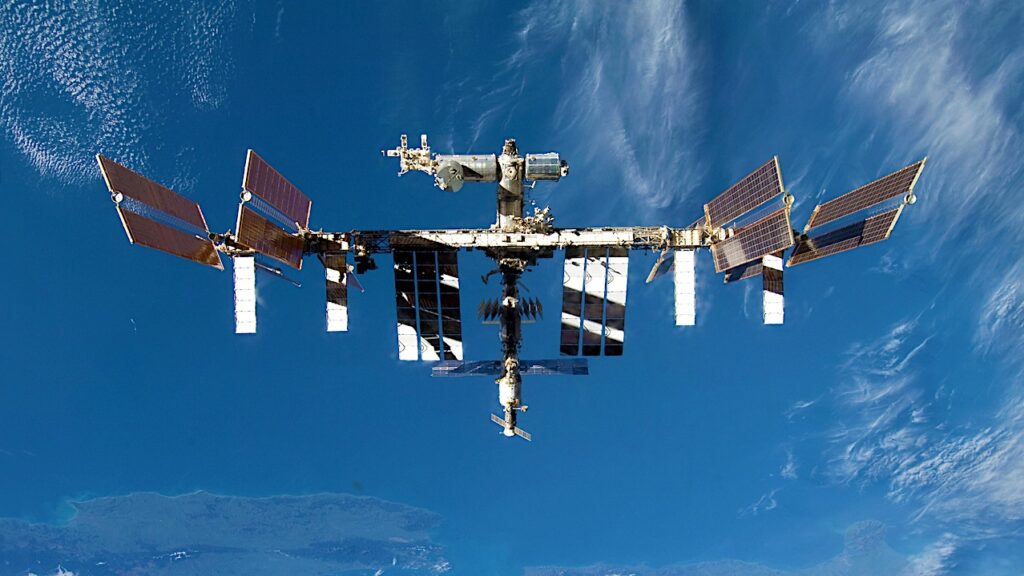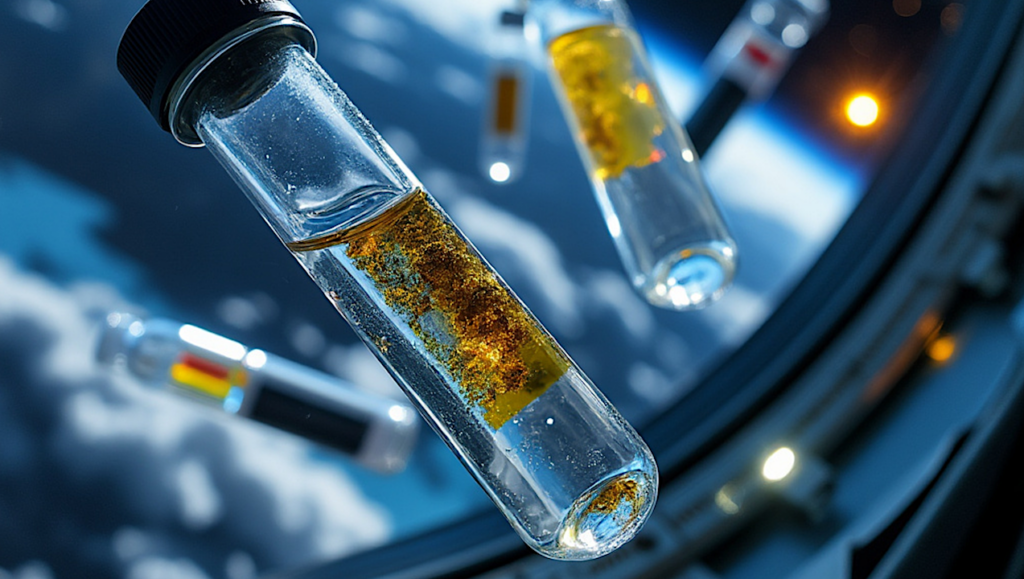NASA Spaceline Current Awareness List #1,156 3 July 2025 (Space Life Science Research Results)

Astronaut Thomas Pesquet works on the Cardinal Muscle investigation in the Life Sciences Glovebox aboard the International Space Station. Credits: NASA
The abstract in PubMed or at the publisher’s site is linked when available and will open in a new window.
Papers deriving from NASA support:
- Parafati M, Thwin Z, Malany LK, Coen PM, Malany S.Microgravity accelerates skeletal muscle degeneration: Functional and transcriptomic insights from an ISS muscle lab-on-chip model.Stem Cell Reports. 2025 Jun 26;102550. Online ahead of print.Note: ISS results. This article may be obtained online without charge.
Journal Impact Factor: 5.1
Funding: “We acknowledge the following funding sources: National Institutes of Health grant 5UG3/UH#TR002598 (S.M.), National Institutes of Health grant 5UH3TR002598-05S1 Admin Suppl (S.M.), University of Florida Prosper Bridge Fund (M.P.), Center for the Advancement of Science in Space #UA2019-011 (S.M.), and NASA task order to Space Tango.” - Yang J, Kim HD, Barrila J, Lee SH, Nickerson CA, Ott CM, Israel SA, Choukér A, Yang JY.Navigating mental health in space: Gut-brain axis and microbiome dynamics.Exp Mol Med. 2025 Jun 30. Review. Online ahead of print.PI: J. YangNote: This article may be obtained online without charge.
Journal Impact Factor: 12.9
Funding: “J.Y. conceived and wrote the manuscript. H.-D.K. wrote part of the manuscript. J.Y., S.- H.L. and H.-D.K created the figures. J.B., A.C., C.M.O., C.A.N. and S.A.I. revised the manuscript. J.-Y.Y. conceived and supervised manuscript preparation. All authors have read and agreed to the published version of the manuscript. This work was supported by NASA grant 80NSSC19K1597, Brain Pool program funded by the Ministry of Science and ICT through the National Research Foundation of Korea (grant nos. RS-2023- 00263702 and NRF-2018R1A5A2023879) and Learning & Academic research institution for MS and PhD students and Postdocs (LAMP) Program of the National Research Foundation of Korea (NRF) grant funded by the Ministry of Education (grant no. RS2023-00301938). A.C. was supported by the German Space Agency (DLR, grant no. 50WB2222).” - Ulusoy U, Reisman G.Investment construct in human autonomy teaming for deep space habitat operations.Acta Astronaut. 2025 Nov;236:117-27.Note: From the abstract: “Operations in deep space habitats will differ significantly from those in Earth orbit. Astronauts must perform many tasks independently due to communication delays and bandwidth limitations. As intelligent systems (e.g., autonomous agents) are integrated to support astronauts in various tasks, it is crucial that these systems are utilized effectively. Since such systems depend on human interaction to learn, it is essential that astronauts are willing to assist them. This paper proposes a novel approach to explaining the utilization of autonomous agents through a new construct called Investment in human-autonomy teaming.”
Journal Impact Factor: 3.4
Funding: “This study is funded by NASA under grant number 80NSSC19K1052 as part of the Habitats Optimized for Missions of Exploration (HOME), which is a NASA Space Technology Research Institute (STRI).” - Brumfield KD, Enke S, Swan BK, Carrasquilla L, Lee MD, Stern DB, Gieser L, Hasan NA, Usmani M, Jutla AS, Huq A, Caviness K, Goodrich JS, Bull R, Colwell RR.Hybridization capture sequencing for Vibrio spp. and associated virulence factors.mBio. 2025 Jun 25;e0051625. Online ahead of print.Note: This article may be obtained online without charge.
Journal Impact Factor: 5.1
Funding: “This research was supported in part by an appointment to the Intelligence Community Postdoctoral Research Fellowship Program at University of Maryland, College Park, administered by Oak Ridge Institute for Science and Education (ORISE) through an interagency agreement between the US Department of Energy (DOE) and the Office of the Director of National Intelligence (ODNI) awarded to K.D.B. and R.R.C. Further support was provided by the National Science Foundation (OCE1839171 and CCF1918749), National Institute of Environmental Health Sciences, National Institutes of Health (R01ES030317A), and the National Aeronautics and Space Administration (80NSSC20K0814 and 80NSSC22K1044), awarded to A.H., A.S.J., and R.R.C. This work was also funded in part under agreement no. HSHQDC-15-C-00064 awarded to Battelle National Biodefense Institute (BNBI) by the Department of Homeland Security (DHS) Science and Technology Directorate (S&T) for the management and operation of the National Biodefense Analysis and Countermeasures Center (NBACC), a Federally Funded Research and Development Center.”
Other papers of interest:
- Yagi-Utsumi M, Yanaka S, Burton-Smith RN, Song C, Ganser C, Yamazaki C, Kasahara H, Shimazu T, Uchihashi T, Murata K, Kato K.Microgravity-assisted exploration of the conformational space of Amyloid β affected by Tottori-Type familial mutation D7N.ACS Chem Neurosci. 2025 Jun 24. Online ahead of print.Note: ISS results. From the abstract: “The amyloid β (Aβ) Tottori variant (D7N) exhibits unique aggregation behaviors and altered fibril formation, posing challenges for structural characterization. To overcome this, the microgravity environment on the International Space Station was employed to study Tottori-type Aβ40 fibril formation and structure.”
- Guidetti R, Jensen AB, Copplestone D, Heer M, Pittia P, Rebecchi L, Berggren Å.Insects in outer space: Assessing the effects of microgravity on edible and model insect species for spaceflight food system.Front Physiol. 2025 Jul 1;16:1622401. Review.Note: This article is part of Research Topic “Innovations in Tools and Methods for Life Sciences Research in Space” (https://www.frontiersin.org/research-topics/68978/innovations-in-tools-and-methods-for-life-sciences-research-in-space). The Research Topic also includes an article from previous Current Awareness List #1,155 https://doi.org/10.3389/fphys.2025.1599005. Additional articles will be forthcoming and may be found in the link to the Research Topic. This article may be obtained online without charge.
- Holden AV.Spaceborne and spaceborn: Physiological aspects of pregnancy and birth during interplanetary flight.Exp Physiol. 2025 Jun 27. Review. Online ahead of print.Note: This article may be obtained online without charge.
- Hao W, Yun C, Patil S, Qiu W, Qian A, Lin X.Chapter 5 – Space molecular cell biology.In: Qian A-R, Lin X, Patil S, Farooq HMU, eds. Space Biology and Space Biotechnology: Academic Press, 2025. p. 87-98.
- Li Z, Zhao L, Zhang G, Mi D, Sun Y.Optimized combination methods for exploring novel space environment-responsive genes and their roles: Insights from space-flown C. elegans and their implications for astronauts.Int J Radiat Biol. 2025 Jun 27;1-21. Online ahead of print.Note: From the abstract: “We employed an optimized combination algorithm that integrated two co-expression network analysis methods and four machine learning-based models to identify space environment-responsive genes (SEGs) in space-flown C. elegans. The expression levels and associated biological processes of human orthologues of identified C. elegans genes were further analyzed using data from the JAXA CFE and NASA Twins studies.”
- Skotnicky P, Mondal SR.Minds in microgravity: The psychological journey of space travelers.In: Mondal SR, Vrana V, Das S, eds. Pioneering the New Space Economy through AI and Immersive Technologies: Economic Development and Tourism Opportunities in Space. Singapore: Springer Nature Singapore, 2025. p. 239-60.
- Matache IM.Beyond gravity: Leveraging gene plasticity to mitigate spaceflight-induced pathologies.Proteomics. 2025 Jun 27;25(11-12):e00087.Note: This article is a Commentary.
- Murali A, Sarkar R.Impact of gravitational forces on red blood cell dynamics in biofluid suspension.Life Sci Space Res. 2025 Jul 1. Online ahead of print.Note: From the abstract: “The growing interest in space exploration and human spaceflight has highlighted the critical challenges posed by microgravity on human physiology. Among these, a significant issue is space anemia, which adversely affects red blood cells and alters its behavior. RBC depends on biofluids, for their systemic transport, a process that experiences disruption in the microgravity environment. This study aims to quantitatively address the puzzle of how red blood cells are influenced by gravity when they are suspended in bio-fluid.”
- Pérez-Díaz S, Baselet B, Lovric A, Lundberg TR, Neefs M, Daenen L, Rullman E, Fernandez-Gonzalo R.Long non-coding RNAs Kcnq1ot1 and Lncpint are involved in skeletal muscle atrophy induced by the space exposome.J Physiol. 2025 Jun 29. Online ahead of print.Note: This article may be obtained online without charge.
- Hao J, Zhang Y, Li N, Chen Z, Chang J, Deng Y.Microgravity-induced cognitive decline: Investigating the pathogenic mechanisms of RyR2 hyperphosphorylation and S107 intervention.Faseb j. 2025 Jul 15;39(13):e70743.Note: Hindlimb unloading study.
- Markiewicz M, Galanty A, Kołodziejczyk A, Żmudzki P, Prochownik E, Zagrodzki P, Paśko P.Bioactive compounds accumulation in Brassica sprouts grown under microgravity and darkness: A novel approach to functional foods.Food Chem. 2025 Jun 24;491:145324.Note: A random positioning machine was used in this study.
- Tripoli F, Ridolfi L, Scarsoglio S.Assessing the cardiac function from micro-gravity to hyper-gravity conditions through a validated multiscale modelling approach.J Physiol. 2025 Jun 25. Online ahead of print.
- van Rijthoven S, van Loon J.Aging and altered gravity: A cellular perspective.Faseb j. 2025 Jul 15;39(13):e70777. Review.
- Zhou XX, Huang XY, Zhang M, Ma XY, Yang H, Xu T, Dao JW, Wei DX.A BMP6 supply system based on PBVHx nanoparticles promotes the osteogenic differentiation of human stem cells in simulated microgravity.Int J Biol Macromol. 2025 Aug;145444.Note: From the abstract: “To continuously stimulate osteogenic differentiation of stem cells under microgravity, we developed an effective bone morphogenetic protein 6 (BMP6) sustained-release system based on nanoparticles (NPs) based on medical poly (3-hydroxybutyrate-3-hydroxyvalerate-3-hydroxyhexanoate) (PBVHx), which promotes osteogenic differentiation in human bone marrow-derived stem cells (hBMSCs). The system involves the loading of hydrophobically modified BMP6 onto PBVHx nanoparticles via soybean lecithin (sB6), followed by modification with positively charged poly-l-lysine (PLL) to enhance cellular uptake, thereby forming sB6/PBVHx@PLL-NPs.”
- Zorpas AA, Inglezakis VJ, Papamichael I, Razis P, Voukkali I, Pérez-Gimeno A, Naddeo V, Rodríguez-Espinosa T, Loizia P, Navarro-Pedreño J.Planetary sustainability science and technology: Integrating astro-soil, astro-environmental engineering and astro-habitat engineering for space exploration.Sci Total Environ. 2025 Aug;992:179959.
- Jiang SP, Lin BQ, Zhou XQ, Li MH, Feng ZC, Qin YY, Lin SQ, Zhou ZQ, Peng Y, Li L.Airway organoid models as pivotal tools for unraveling molecular mechanisms and therapeutic targets in respiratory diseases: A literature review.Ther Clin Risk Manag. 2025 Jun 24;21:975-86. Review.Note: This article may be obtained online without charge.
- Ren Y, Gou B, Chen R, Gan Y, Wang M, Jiang A, Shi J, Fan H.Effects of computer mouse control-display gain on upper extremity muscle fatigue, subjective fatigue and user performance.Work. 2025 Jun 25;10519815251351849.
- Yu Y, Zhan Z, Shi J, Su J, Liu L, Liao J, Yan P, Xia D, Zhang Q, Qian A, Chen W, Xu T, Guo X, Liang Q, Wang G, Tang S, Yin C.Mechano-sensitive long noncoding RNA AK091765 inhibits bone formation via microRNA-489-3p binding.Acta Astronaut. 2025 Nov;236:62-77.Note: From the abstract: “Mechanical stimuli are essential factors which maintain bone homeostasis. A lack of mechanical stress is the main cause of osteoporosis in astronauts in space and also aged individuals. However, the molecular mechanisms whereby mechanical stimuli regulate bone formation remain poorly understood. Recent investigations have shown that long noncoding RNAs (LncRNAs) are important regulators of bone formation under different mechanical conditions. We previously reported a mouse derived Lnc-DIF (Differentiation Inhibiting Factor) as a negative regulator in osteoblast differentiation. In this study, we identified AK091765 as a human derived LncRNA with high sequence similarity to Lnc-DIF.”
- Zhang F, Zheng L, Wu Y, Ding Q, Lü S, Lü D, Long M.E-cadherin negatively regulates hESCs endodermal differentiation under varied substrate stiffnesses.Cell Mol Life Sci. 2025 Jun 23;82(1):245.Note: From the abstract: “Intercellular adhesion is crucial in regulating stemness maintenance and differentiation initiation of embryonic stem cells (ESCs), which is also cooperated with extracellular mechanical microenvironment. Here an in vitro model was used to elucidate the effects of E-cadherin complexes on definitive endoderm (DE)-directed differentiation of hESCs (H1 cells), when the cells were seeded on polyacrylamide hydrogels with varied stiffnesses.”
Astrobiology, space biology, space life science, space medicine, Microgravity, ISS,








